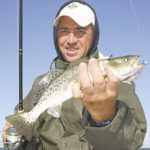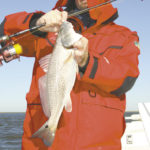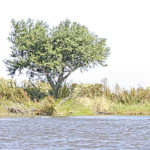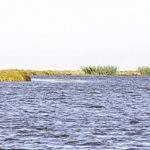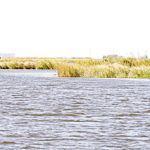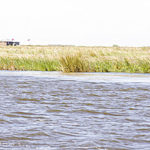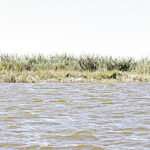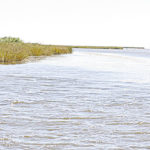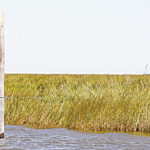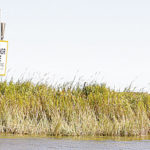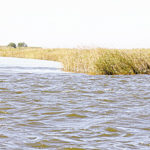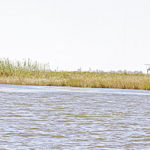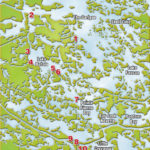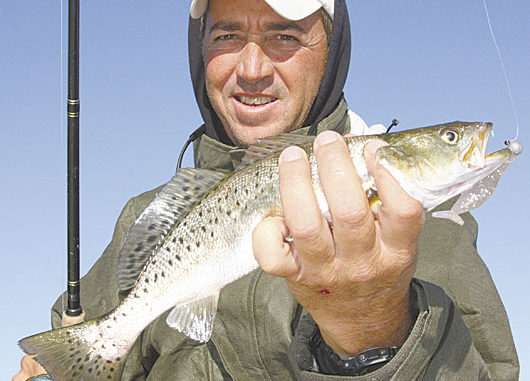
Delacroix is known for its cold-weather fishing, and you’d be hard pressed to find better spots than these.
Capt. Jack Payne can see his own version of a winter wonderland from his front porch. The owner of Sweetwater Guide Service and Marina, Payne poured his pay-to-launch ramp right at the intersection of Bayous Terre Aux Boeufs and Gentilly.
What Payne can see through the liquid lens of Bayou Gentilly are the inside waters around Delacroix Island where anglers can catch big trout and redfish all winter long without having to worry about the weather.
This magical maze of bayous, canals and bays has literally thousands of places to fish, and to hear Payne talk, just about all of them are as good as the next. Even though unfamiliar anglers can stumble upon a good box of fish, Payne thought they could more consistently catch fish by hitting 10 specific spots from Lake Batola to Oak River.
Rather than stack up all 10 spots in one small water body like Lake Batola, spreading out the spots gives anglers a better chance of catching fish no matter what the weather is doing. They range from shallow spots in Batola to deep spots in Oak River.
“That means you’ll be able to catch fish no matter if it’s really cold or really warm,” Payne explained. “And having 10 good spots in different locations means you’ll also be able to get out of the wind.”
To get to the spots Payne points out, leave Sweetwater Marina and head west in Bayou Gentilly. Just as you exit Bayou Gentilly into Little Lake at N29 41.511 x S89 47.379, turn south, and travel approximately a mile and half toward the isolated, ball-shaped oak tree in the distance.
“This tree is the opening of the Pencil Canal,” Payne said. “And from the Pencil Canal, you can easily get to Lake Batola or Oak River. If you fish all these spots, you’ll wind up making a triangle between these three areas.”
And don’t expect to catch a bunch of popcorn trout. Payne says the big trout that come from Black Bay during the summer are the same trout that have transitioned to these very waters. It wouldn’t be unusual to catch trout over 4 pounds, but a box of trout between 2 and 4 pounds tends to be the norm around Delacroix during the winter.
If you want to go exploring on your own, look for areas with clean water that offer a combination of deep holes with shallow flats nearby. Fish the deep water early and when it’s really cold, and move up on the flats later in the day and during the warming trends.
But why would you want to look for your own when Payne pointed out these 10 spots?
• No. 1: Pencil Canal
N29 41.511 x W89 47 379
Only 10 minutes from Sweetwater Marina, the mouth of the Pencil Canal is the first stop along Payne’s wintertime triangular route. This spot is easy to identify because it an intersection with four corners, there is a gas well on one corner, and a single, round oak tree grows on another point.
“This is a redfish and trout spot around all these islands,” said Payne. “Fish under a popping cork with either live shrimp, live cocaho or a plastic. Fish all four of these corners. You’ll have to deal with some boat traffic passing through, but it’s well worth your time.”
During a falling tide, trout and redfish from the surrounding cuts move into this intersection to feed on all the bait washing through. Although there are some shell spots around, Payne says most of the bottom is mud. It really doesn’t matter, though, because the four points are the main attraction.
“You can also move up into the little canal to the west,” Payne added. “There’s a good grass line in there that creates a wall. Fish move up and down that wall, and if you have your bait in there, they’ll eventually see it or smell it.”
• No. 2: Mouth of Bayou Batola
N 29 41.130 x W 89 49.124
After leaving the mouth of the Pencil Canal, Payne says to turn to your right at N29 40.281 x S89 47.368. This cut takes you on a straight shot over to Lake Batola, where you can continue on your triangular journey. The second stop is at the mouth of Bayou Batola where it meets Lake Batola.
“What you’ve got here is a shelf — a little hill where the bayou comes up into the lake,” he said. “It’s about 6 feet in the lake, but here at the mouth it goes down to about 10 feet. I like to fish under a cork, but if it’s not working, I resort to fishing the bottom. You can catch trout here until your hands fall off.”
Other than the trout, Payne says redfish and bass patrol the grass around the banks. Both respond well to spinnerbaits and gold spoons. But you could also catch a bunch of reds by fishing either live or dead shrimp under a popping cork.
“I like to drift fish this spot for the trout,” Payne added. “I’ll go up about 300 or 400 yards and float back with either tide. It really doesn’t matter if it’s rising or falling, but I do like falling better. When you drift, stay in the middle and cast back to either side. Plastics are good here, too — opening night and purple/chartreuse.”
• No. 3: Batola Cut One
N29 40.960 x W89 49.202
This spot is one of two cuts that drain into Lake Batola that Payne says is definitely worth a stop. In fact, there’s no need to jump from this cut to the second because the bank between the two cuts can be just as productive as the cuts themselves, especially for redfish.
“Basically you want to fish just a popping cork here,” Payne advised. “There’s not too much on the bottom here. There are some oysters and shells on bottom, but I’ve always done best under the cork. Set your bait about 3 or 3 1/2 feet under the cork, and you’ll catch them. You can really turn them on with that cork.”
One thing about this particular spot that Payne made sure to point out was that it can produce even if the wind is churning and has the water a little chocolate-looking. Move around if you want to get out of the wind, but there’s no reason to shy away from this cut.
“Opening night is my favorite color plastic,” Payne said, “but there’s something about chartreuse at this particular cut. The real trick is to pop your cork consistently to let the fish know where you’re at.”
• No. 4: Batola Cut Two
N29 40.717 x W89 49.165
There’s not much different at spot four than what you will find at spot three. It’s just another awesome cut in Lake Batola where you can catch 1 1/2- to 3 1/2-pound trout all day long. If there is a difference, Payne said it is that he does have some success fishing the bottom here as opposed to the other cut.
“I guess this spot has more shell on the bottom,” Payne said. “A lead head jig gets down there in those shells, and when it hits them it makes a tinking sound. When those trout and redfish hear that tinking sound, it’s like somebody ringing the dinner bell. They’ll come over to see what’s going on.”
Payne’s best trout bite typically comes when he stays about 40 feet out in front of the cut and casts back into the middle of the cut. Trout seem to prefer the middle of this cut, whereas redfish like to get more up on the banks.
“When fishing the bottom for trout, I never fish more than a 1/4-ounce jighead,” Payne added. “I might go lighter if there’s no wind and not much current, but I stick with the 1/4-ounce head most of the time. If you’re after redfish, get against the banks with shrimp under a cork.”
• No. 5: Roseau Cane Point
N29 40.506 x W89 48.217
As you move south in Lake Batola, Payne said to make sure and stop at this point marked by a wide patch of roseau cane. This entire spot is covered with shells on the bottom, and speckled trout gang up on top of the shells, especially when the tide is moving.
“You can fish around either side of the point, but the best way to fish it is to get in front of the point about 50 yards and work your way straight to the point,” Payne said. “The shells are about 5 feet deep, so a popping cork set at 2 1/2 feet is just about right.”
Ideally, Payne would like to be able to drift toward the point without making much disturbance with his trolling motor. Whether it’s the confined area or the relative shallow water, the trout here get a little spooky when the trolling motor comes on.
“If you catch a fish, anchor down and sit on them a while,” Payne said. “And other than the popping cork, you can fish a live shrimp on bottom with a 1/4-ounce jighead.
“Catch your redfish along the edges of the points with shrimp under a cork, spinners or spoons.”
• No. 6: No Name Bayou
N29 40.368 x W89 48.089
From Lake Batola, head south toward the bayou that will take you into Pointe Fienne. Payne wasn’t sure that this bayou had a name, and no maps show it with a name. Whatever you want to call it, this is a great spot for bottom fishing.
“The bottom is about 6 feet deep in this canal, and there are fish through the entire thing,” Payne said. “I recommend staying about 25 feet off this first main point, though, and casting back toward the middle.”
Although he favors fishing the bottom here with a live shrimp on a Carolina rig with a 1/4-ounce barrel weight, Payne did say a popping cork would work with shrimp or plastics as long as you set your bait deep enough.
“Go with at least 3 1/2 feet,” he added. “And if you’re going with the cork, try fishing the edge of the grass line here with either the live shrimp or dead shrimp for the redfish. You can also fish the grass with spinnerbaits for the bass.”
• No. 7: Pointe Fienne
N29 39.444 x W89 47.349
The intersection where the Pencil Canal runs into Pointe Fienne is one of the busiest places in all of Delacroix. According to Payne, it wouldn’t be unusual to see upwards of 20 or 30 boats all fishing Pointe Fienne. And many of them are going to pass through this spot. Don’t let the boats scare you, though, because you’ll be missing out on excellent fishing if you do.
“This entire area is a shell bottom,” Payne said. “And my favorite thing to do is sit out from the mouth where the Pencil Canal opens up and cast right back into the middle of it with live shrimp Carolina rigged on bottom.”
One of the reasons this particular spot is so productive is that it is a major migration route for trout moving in for the winter. Of course, most of them are already in by now, but it still serves as a staging area for fish moving from Bay Jack Nevette on up to Grand Lake and Lake Lery.
“If the fish aren’t biting at the mouth of the Pencil Canal,” Payne added, “try backing out into Pointe Fienne and drift fish out there with everybody else with a popping cork. You’ve got about a 3/4-mile drift you can make back toward Bay Jack Nevette. Just be courteous to everybody around you.”
• No. 8: Oak Drop One
N29 37.996 x W89 47.365
Right where the Pencil Canal empties into Oak River is a sharp drop off into deeper water. Most veteran anglers on this side of the Mississippi River will tell you to find a place during the winter with a combination of deep and shallow water; this spot fits that bill perfectly.
“I like to get out in Oak River and cast back into the Pencil Canal,” Payne said. “I mainly fish the bottom with a 1/4-ounce jighead with an opening-night plastic, but you could also Carolina rig live shrimp. When the tide falls hard, you may have to back off and get in the sides of the eddies.”
The bay just north of this cut offers some exceptional warm-weather and later-in-the-day fishing with popping corks. It averages about 4 feet deep, and trout like to get up there and hustle all the shrimp when it’s warm.
“You can also catch some big redfish and drum in the cut by fishing cracked crab on bottom with a Carolina rig,” Payne said. “There are a few little humps and ledges all confined in this mouth, and if you have some electronics, you can easily spot what holds the fish.”
• No. 9: Oak Drop Two
N29 38.089 x W89 47.551
This cut between Skippy Bay and Oak River is very much like the previous spot. However, being that this one is closer to the western end of Skippy Bay, it seems like more bait washes through this one during a falling tide. Trout and reds love to stack up on the 17-foot ledge to get full.
“The bottom in Oak River in front of this cut is 20 feet deep,” Payne pointed out. “But the lake on the other side is only 3 feet. And this 17-foot drop happens over a span of about 12 feet. It’s a perfect spot for throwing a plastic up on the shallow ledge and bumping it back down the drop.”
Whereas the Pencil Canal drop off has short, stubby points at its mouth, the points that define this cut are longer and leaner. That means there is more area for fish to get out of the current on either side.
“Fish it the same way, though,” Payne said. “Hit the ledge with the plastics and Carolina-rigged live shrimp, and move up in the shallow water to throw a popping cork later in the day. Don’t stay out of the shallows just because it’s cold or early, though, because they’ll sometimes be up there when you least expect it.”
• No. 10: Bayou Barge
N29 37.840 x W89 47.083
Bayou Barge is the main drain coming from Pointe a la Hache, and this is the mouth through which all that water moves. The drain itself averages about 10 feet deep, but it dumps off into much deeper water at this spot. That makes it an excellent spot for the coldest of days.
“It’s good in the cold and wind because it’s mainly a bottom spot,” Payne explained. “You can’t really fish up with a popping cork when its windy because the fish can’t hear the sound in all the wave action, and they have trouble spotting your bait because the water’s all churned up.”
Payne sticks with fishing the bottom with a Carolina-rigged shrimp or cocaho. He also bumps a plastic rigged on a 1/4-ounce jighead on bottom. But he doesn’t just stick in the mouth, especially if he’s after redfish.
“You can go up in the drain some and fish the edges with dead shrimp under a cork for the redfish,” Payne said. “But if the tide is falling, get in the mouth and stick with the trout. You’ll catch trout, redfish, drum, sheepshead — whatever you want to catch.”
Contact Capt. Jack Payne at 504-453-8382.
